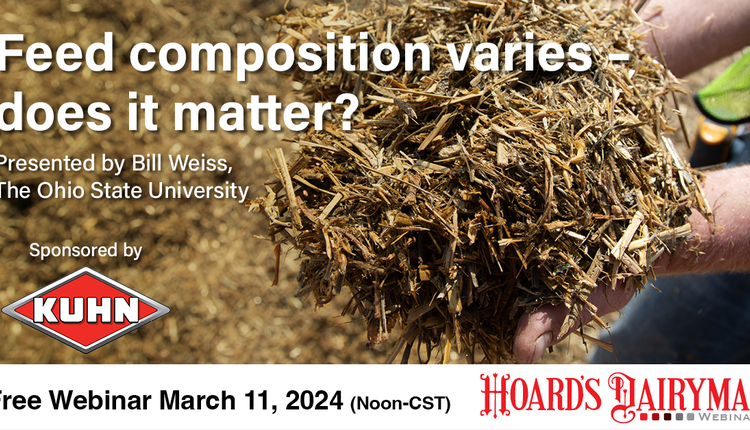 Randy Shaver, University of Wisconsin-Madison, presented the monthly Hoard's Dairyman webinar "Update on starch utilization by dairy cows" on Monday, June 9, a subject he's extensively researched for the past decade.
Randy Shaver, University of Wisconsin-Madison, presented the monthly Hoard's Dairyman webinar "Update on starch utilization by dairy cows" on Monday, June 9, a subject he's extensively researched for the past decade.It's a growing area of interest as half to three-fourths of corn's energy comes from starch. And starch is important for lactation as it provides carbohydrates that drive feed intake, milk production, components and feed efficiency.
However, with elevated corn prices (grain and corn silage) over historical costs, producers look to alternatives. High-fiber byproducts can replace some dietary starch, but reduces feed efficiency. Common examples include soy hulls, wheat midlings and whole cottonseed.
It's not that simple, though. Initial costs on a dry matter basis are lower due to cheaper byproducts, but so is income over feed costs.
Shaver's group evaluated Rumensin in low and normal starch diets. The feed additive boosted milk yield and improved feed efficiency in both groups with few differences between diets.
Sugar supplements are fed to improve starch digestion. Examples include molasses, liquid feed supplements, sucrose, whey and permeate, bakery waste, beet pulp and citrus pulp. Molasses and whey are commonplace, and Shaver encouraged more research into these two as an energy source.
Fat supplements are energy-dense but reduce microbial synthesis. So, while total energy is elevated, rumen activity suffers.
The majority of starch digestion (55 to 85 percent) occurs in the rumen by microbial fermentation. Proprionate synthesized here is later converted to glucose, which drives lactose, and ultimately milk production. In addition to volatile fatty acid production, microbial proteins break down starch in the rumen. Too much starch can lead to metabolic issues such as laminitis and acidosis.
Smaller volumes of starch are handled in the abomasum and small intestine. Minimal digestion in the hindgut is preferred as it's the least efficient site of digestion. Between these three, 80 to 100 percent of starch is broken down.
How is starch digestibility altered? Kernal processing affects particle size and is an important digestibility factor. How it's handled during harvest and storage has major impacts, too. The third is the endosperm type.
Feed samples should be submitted for kernal processing scores. While scores have improved in recent years, there's room for further gains. Shaver compared various labs' results ranging from poor, adequate to excellent. A category jump netted 2 pounds of milk, which could add 4 pounds when going from poor to excellent due to better digestibility and performance.
So what happened inside the cow? Check fecal starch levels. If less than 3 percent of starch is still present, there is no need to investigate. However, if levels are higher, evaluate feedstuffs to determine how she can better use starch and not lose it.
The June presentation was brought by Calibrate® Technologies. (www.calibratetechnologies.com) This June webinar is archived and available for viewing. Past webinars can be found at www.hoards.com/webinars.
 The author is the online media manager and is responsible for the website, webinars and social media. A graduate of Modesto Junior College and Fresno State, she was raised on a California dairy and frequently blogs on youth programs and consumer issues.
The author is the online media manager and is responsible for the website, webinars and social media. A graduate of Modesto Junior College and Fresno State, she was raised on a California dairy and frequently blogs on youth programs and consumer issues.











